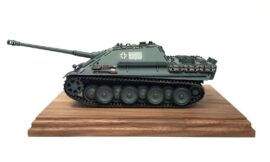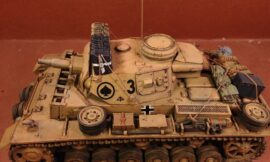The Sturmtiger, officially known as the 38 cm RW61 auf Sturmmörser Tiger, was a German World War II assault gun based on the Tiger I heavy tank chassis. It was designed to provide heavy firepower for urban warfare, capable of demolishing fortified structures and bunkers with its massive 38 cm rocket-propelled mortar. The Sturmtiger’s formidable armament and heavy armor made it one of the most distinctive and powerful vehicles of the war, though it was produced in limited numbers and saw relatively little combat.
Development and Design
The Sturmtiger was developed in response to the challenges faced by German forces during the Battle of Stalingrad and other urban engagements, where the need for a heavily armored vehicle capable of destroying fortified positions became evident. The idea was to mount a large-caliber mortar on a heavily armored chassis, providing the necessary protection and firepower to operate effectively in close combat situations.
The chassis of the Tiger I heavy tank was chosen for the Sturmtiger due to its robust design and heavy armor protection. The superstructure was modified to accommodate the massive 38 cm RW61 L/5.4 rocket-propelled mortar. This weapon was originally designed as a naval depth charge launcher but was adapted for land use. The mortar was capable of firing a variety of ammunition types, including high-explosive and shaped charge projectiles.
Armament and Capabilities
The main armament of the Sturmtiger was the 38 cm RW61 L/5.4 rocket-propelled mortar. This weapon fired a 380 mm rocket-assisted shell, which was capable of demolishing buildings and fortifications with a single shot. The shells weighed around 345 kg (760 lbs) and had an effective range of up to 5,000 meters (5 km). The sheer size and explosive power of these shells made the Sturmtiger an extremely effective tool for urban warfare and bunker-busting operations.
Secondary armament included a 7.92 mm MG 34 machine gun mounted in the front hull for defense against infantry and light vehicles.
Armor and Protection
The Sturmtiger inherited the heavy armor of the Tiger I, with frontal armor up to 150 mm thick and side armor ranging from 60 to 80 mm. This level of protection made it highly resistant to most Allied anti-tank weapons, providing a significant advantage in close combat and urban environments where it was expected to face concentrated enemy fire.
Mobility and Performance
Despite its heavy weight, the Sturmtiger was powered by the same Maybach HL230 P45 V-12 engine used in the Tiger I, producing 700 horsepower. This allowed the Sturmtiger to achieve a top speed of around 40 km/h (25 mph) on roads and approximately 12 km/h (7.5 mph) off-road. However, its weight of nearly 70 tons and the additional strain from the massive mortar limited its mobility, particularly in rough terrain and urban rubble.
Operational History
The Sturmtiger saw limited production and combat use, with only 18 to 19 units built between 1944 and 1945. Its primary role was to support infantry in urban combat, providing devastating firepower to destroy enemy strongpoints and fortifications.
The Sturmtiger first saw combat during the Warsaw Uprising in August 1944, where its ability to demolish buildings and fortified positions proved valuable. It later participated in the Ardennes Offensive (Battle of the Bulge) in December 1944 and in the defense of the German homeland in 1945. Despite its impressive firepower and protection, the Sturmtiger’s operational impact was limited by its small numbers, mechanical issues, and logistical challenges.
Legacy and Impact
The Sturmtiger’s design and combat role highlighted the German military’s emphasis on specialized vehicles for specific battlefield tasks. Its massive firepower and heavy armor made it a formidable opponent in urban and fortified environments, but its limited production and operational deployment meant it had a relatively minor impact on the overall course of the war.
The Sturmtiger’s legacy lies in its unique role as a heavy assault gun designed for urban warfare, influencing post-war armored vehicle design and the development of modern self-propelled artillery and bunker-busting munitions.
Conclusion
The Sturmtiger was a remarkable example of German engineering during World War II, designed to meet the specific challenges of urban and fortified warfare. Its 38 cm rocket-propelled mortar provided unparalleled firepower, while its heavy armor offered significant protection. Although produced in limited numbers and with limited combat use, the Sturmtiger remains an iconic vehicle of the war, symbolizing the extreme measures taken to address the brutal realities of urban combat.















